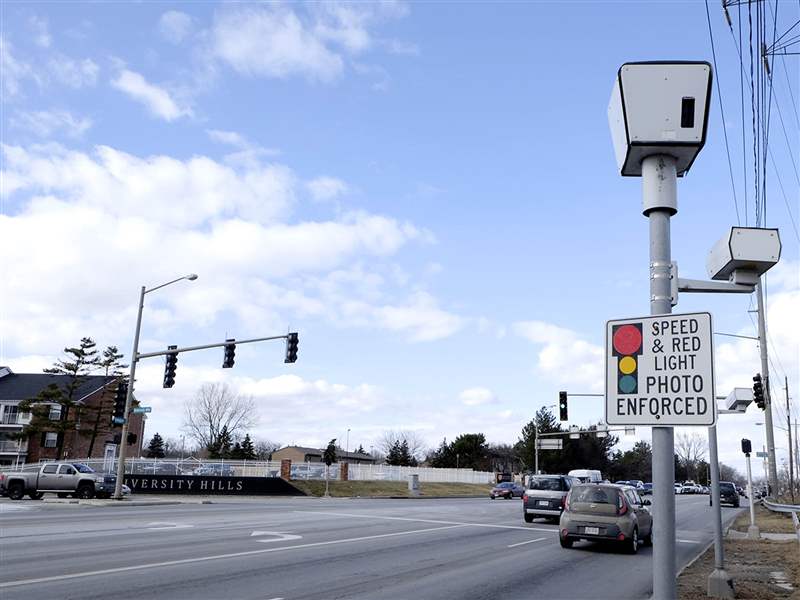
High court sides with Toledo in traffic camera challenge
12/13/2017
The traffic camera on Douglas Road at University Hills Boulevard in Toledo, Ohio on February 17, 2016.
THE BLADE/JETTA FRASER
Buy This Image
COLUMBUS — Months after striking down provisions of a state law restricting cities’ use of automated fixed-location traffic cameras, the Ohio Supreme Court on Wednesday officially applied that decision to programs in Toledo and Springfield.
By a vote of 4-3, the high court sent the case back to Lucas County Common Pleas Court under order to apply a decision out of Dayton. In the 5-2 Dayton ruling from July, the court found some restrictions placed on the operation of stationary, automated red-light and speed enforcement cameras unconstitutionally infringed on home-rule authority.
The court in that ruling struck down provisions requiring a police officer to be present at camera locations, prohibiting fines if a driver travels less than 10 mph over the speed limit in most areas, and requiring cities to conduct safety studies and public-information campaigns before issuing civil citations.
"It's a vindication for home rule and allows cities to make decisions based upon our authority," Toledo Mayor Paula Hicks-Hudson said of the court’s action Wednesday.
Mayor Hicks-Hudson said the 2018 revenue projection for the city’s 43 stationary cameras was $1.72 million, based on the expectation that the city's ability to use the devices would be upheld by the state Supreme Court.
Justice Pat DeWine, among the three dissenters on Wednesday, argued the Dayton decision was so “fractured” there was no majority view to apply to the appeals in Toledo and Springfield.
“The trial court is in no better position now than when it first heard the case to determine the constitutionality of the provisions it previously addressed that were not addressed by this court in Dayton,” he wrote.
Justice DeWine said the ruling did not resolve other issues raised in Toledo and Springfield. Among them were questions of whether a police officer must review camera photo evidence to decide whether a violation occurred and whether a city may assume the owner of a vehicle caught by a camera was also the driver at the time.
“This court has never addressed these provisions, and Ohio municipalities wait to see whether they must comply with them,” Justice DeWine wrote.
Justice DeWine said the local courts should apply the Dayton case where it fits but the high court should continue to consider the other issues not addressed by Dayton.
Toledo had argued it already does much of what the state law required. But, in particular, it argued the requirement that a police officer be present to witness violations defeated the cameras’ purpose and would make them economically infeasible to continue.
Chief Justice Maureen O’Connor, Justice Judith French, Justice Pat Fischer, and 10th District Court of Appeals Judge William Klatt all voted to apply the Dayton decision to the two other cities. Judge Klatt sat in the place of Justice Terrence O’Donnell, who had recused himself from the case.
In addition to Justice DeWine, Justices Sharon Kennedy and William O’Neill dissented. Justice Kennedy had been in the majority in the Dayton case.
Justice DeWine is the son of Attorney General Mike DeWine, whose office had defended the law. The justice has taken the position he need not recuse himself unless his father personally argues a case.
Both the common pleas court and 6th District Court of Appeals had struck down the law.
“The Dayton case is a great victory for home rule and local democracy,” said Joe McNamara, a senior attorney in Toledo’s Law Department. “It’s clearly applicable to issues raised in the Toledo case, and Justice DeWine has a point in that there were issues of local self-government that Toledo raised in its case that weren’t decided by Dayton. Nevertheless, Dayton certainly applies and affirms home-rule powers.”
Another case is pending before the Supreme Court to determine whether the General Assembly was within its rights to punish cities like Toledo that won court orders allowing their camera programs to continue while the law was challenged.
The state had passed a budget provision to withhold state dollars from such cities equal to fine amounts from citations they issued.
The city of Toledo budgeted $2 million in revenue from the fixed cameras for 2017, and collected about 78 percent of that total — about $1.57 million — through Oct. 31. That contrasts with the handheld speed cameras used by Toledo police, which have brought in more than $4.4 million through the end of October, or 191.5 percent of the $2.3 million budgeted for 2017.
Contact Jim Provance at jprovance@theblade.com or 614-221-0496.